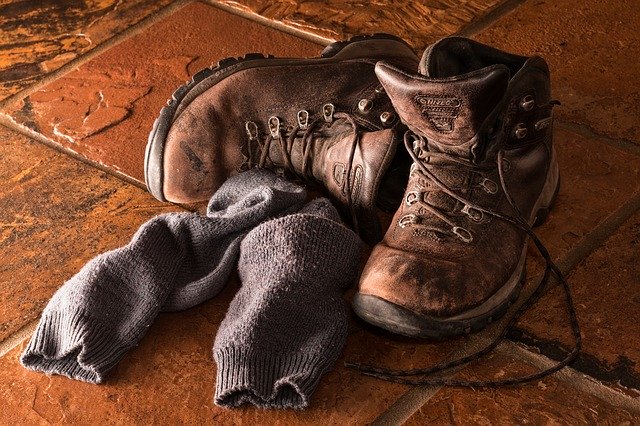Table of Contents
Some links on posts are affiliate links and will earn us a commission from qualifying purchases
What’s that? You think your feet are wet whilst out walking? But your walking boots are not that old, surely not? They must be faulty!! Or maybe not.
It is quite possible that your walking boots are leaking, even if they are not that old? There could be several reasons, but the most likely is the build-up of salty sweat on the inside or dirt on the outside – both of which can be helped with regular cleaning.
The last thing you want is soggy socks whilst you are out hiking, especially at the start of your walk. As well as being uncomfortable, you also have a higher risk of blisters. So let’s take a look at why your walking boots are leaking, how to minimise the chance of them leaking, how to test for leaks, and what to do if they do leak.
Why are your walking boots wet on the inside?
There are several reasons that your walking boots may be wet on the inside, and it’s important to find out which of these it is, so you can take the necessary action to stop it happening on every walk. The 5 main reasons are:
A hole in the sole
Soles can be punctured by thick brambles, sharp stones, or even barbed wire, drawing pins or broken glass! Obviously it’s best to avoid these if at all possible, but sometimes the terrain you are on will mean sharp stones or rocks are the norm. If you do find your soles is compromised then you can do a temporary fix using a waterproof adhesive, which may last up to a year or so.
Alternatively, you can take them to be re-soled, ideally at an outdoor walking specialists.
Clogged up inner membrane
This is surprisingly common, as most of us don’t realise that when cleaning out boots we should pay as much attention to the inside as well as the outside. As we walk our feet sweat, and that sweat escapes the boots through the pores in the inner membrane. Water vapour is much smaller than water droplets, so it can escape the smaller pores whilst they don’t let rainwater in.
But over time these pores get clogged up with the salt from the sweat, so it’s important to clean the insides too to remove that salt.
Excess dirt on the outside
If we don’t clean the outside of our walking boots properly, the pores will get clogged up with dirt. And as such our sweat will build up inside again as it has no means of escape. Get into the habit of cleaning and reproofing your boots regularly, and if they are dirty after a walk, make sure you clean them as soon as you can – ideally straight away!
Incorrect use of waterproof trousers and gaiters
Gaiters are great at keeping moisture out of your boots, but if you use them with waterproof trousers at the same time please ensure you wear them under the trousers! If you wear over the top you run the risk of rainwater rolling down your trousers and getting under the gaiters, and then rolling straight down to the insides of your boot.
Wearing the gaiters below your waterproof trousers will stop that from happening, as the raindrops will run to the bottom of your trousers, onto the outside of your gaiters, and straight to the floor.
How to minimise the chances of your walking boots leaking
The best way to minimise the chances of your boots leaking and your feet getting wet is to ensure good maintenance. A thorough inspection after every walk is a good habit to get into, and one that may well save you money by maintaining your boots rather than replacing them.
How to test your walking boots for leaks
The easiest way to test for leaks is to pour water inside your boots, put them in a bowl, and see if water leaks out over time. Of course this makes them wet and it may take a couple of days for them to dry out fully, so don’t do this if you intend using them in the near future.
Remove the insole to prevent them from having to dry. Then pour some lukewarm water inside about half-way up and place in a spare washing-up bowl to catch any water that may escape. Check back on them after a few hours to see if the water is still ALL inside, or if some has escaped into the bowl.
After you have done the test it’s best to empty the water out and allow them to dry naturally at room temperature. Fill them with newspaper to keep their shape, and DON’T put in front of a fire or use a hairdryer, as this will damage the material of the boots anyway!
What to do if your walking boots leak
If you do find that your boots are leaking from the sole, then I feel it’s better to get them re-soled at a specialist outdoor supplier or shop that offers that service. That is, if they are not within their manufacturers guarantee – if they are then get in touch with them direct!
As mentioned above, you can use waterproof adhesive to fix the hole yourself, but it may well be fiddly and with no guarantee of you getting it right. But of course, it’s a much cheaper solution that may suit you at the time.
If however you find that the membrane has been torn, then there’s probably nothing more to do than cheer yourself up with some retail therapy and buy yourself a new pair of walking boots.
Conclusion – Are your walking boots leaking?
Walking boots that leak are quite simply unpleasant to walk in if it’s wet or you are likely to walk through water or wet grass. If you think your boots are leaking then why not do the leak test to be sure, and then take remedial action, depending on the results. Hopefully they won’t actually be leaking, but it’s a case of better cleaning and maintenance.
Related posts
The more I read up and learn about walking in different seasons, the more often I hear people say that gaiters are essential equipment for people walking or hiking. And having got very muddy the...
What to do if you are caught in a thunderstorm while out walking
Whilst electrical thunderstorms can be quite exhilarating to watch in the distance, from the safety of your own home, what should you do if you are caught in a thunderstorm while out walking? If...


